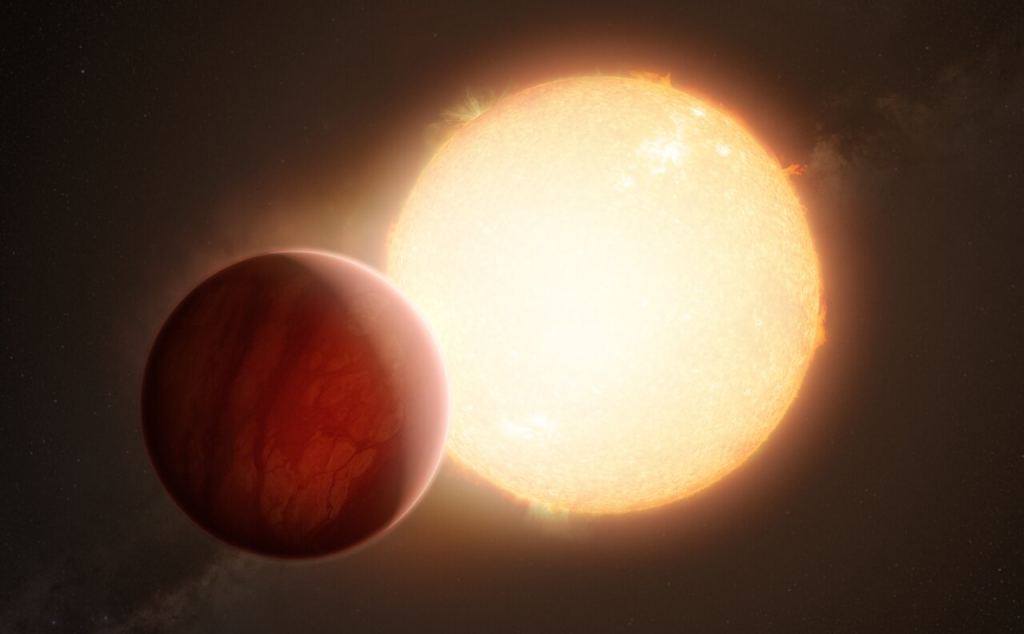The current exoplanet census contains 5,832 confirmed candidates, with more than 7,500 still awaiting confirmation. Of those that have been confirmed, most have been gas giants ranging from Neptune-like bodies (1992) to those similar to or many times the size and mass of Jupiter and Saturn (1883). Like the gas giants of the Solar System, astronomers generally theorized that these types of planets form in the outer reaches of their star system, where conditions are cold enough for gases like hydrogen and helium and volatile compounds (water, ammonia, methane, etc.) will condense or freeze solid.
However, astronomers have noted that many of the gas giants they’ve observed orbited close to their stars, known as “Hot Jupiters.” This has raised questions about whether or not gas giants and other planets migrate after formation until they find their long-term, stable orbits. In a new study, a team from Arizona State University’s School Of Earth and Space Exploration (ASU-SESE) examined the atmospheric chemistry of several Hot and Ultra-Hot Jupiters. After examining WASP-121b, the team came to the unexpected conclusion that it likely formed close to its star.
The research was conducted by Graduate Associate Peter C. B. Smith and other members of the ASU-SESE. They were joined by exoplanet researchers from the Steward Observatory, the Italian National Institute for Astrophysics (INAF), the Trottier Institute for Research on Exoplanets (iREX), the Centre for Exoplanets and Habitability (CEH), and multiple universities. Collectively, they are part of the Roasting Marshmallows Program, and their latest research was presented in a paper appearing in The Astronomical Journal.
Members of this program are dedicated to studying the atmospheres of hot and ultra-hot Jupiters using the Immersion GRating INfrared Spectrograph (IGRINS), built by the University of Texas and the Korea Astronomy and Space Science Institute (KASI). The instrument is part of the Gemini South telescope in Chile, one of two telescopes that make up the International Gemini Observatory, funded in part by the U.S. National Science Foundation (NSF) and operated by the National Optical-Infrared Astronomy Research Laboratory (NOIRLab).
This program aims to learn more about the protoplanetary disks from which hot gas giants formed. In the past, scientists assumed that these disks – leftover rocky and icy material from the nebulae that give birth to stars – settle into gradients around their suns that allow certain types of planets to form around them. According to this theory, material closer to the star would consist largely of rocky material since volatiles would turn to vapor, while material farther from the star would consist of icy material since temperatures would be low enough for it to solidify.
Since the material in these disks varies based on the distance from their parent stars, astronomers can measure the abundance of these materials in planetary atmospheres based on their spectral signatures. As a result, they can determine how far from a parent star its planets may have formed. Ordinarily, measuring this ratio requires multiple observations in both visible and infrared light (for rocky and gaseous elements, respectively). However, the team obtained measurements WASP-121b to determine the radio of rocky and gaseous elements thanks to it being an ultra-hot Jupiter.
As a result, the planet’s atmosphere contains vaporized rock and gaseous materials that were detectable using the IGRINS instrument alone and with a single observation! This instrument allowed the team to obtain high-resolution spectral data from WASP-121b as it made a transit in front of its star. Said Smith:
“Ground-based data from Gemini South using IGRINS actually made more precise measurements of the individual chemical abundances than even space-based telescopes could have achieved. Our measurement means that perhaps this typical view needs to be reconsidered and our planet formation models revisited. The planet’s dayside is so hot that elements typically thought of as ‘metal’ are vaporized into the atmosphere, making them detectable via spectroscopy.”
Credit: ESO
The spectra showed that WASP-121b has a high rock-to-ice ratio, indicating that it accreted an excess of rocky material while forming. This suggests the planet formed closer to its star, which was quite a surprise since traditional models suggest that gas giants need much colder temperatures to form. The reason for this became obvious once Smith and his team learned several things about WASP-121b’s atmosphere. On the dayside, temperatures are so hot that rocky material and metals are vaporized into the atmosphere, while powerful winds blow these to the night side, where they condense.
This leads to WASP-121b experiencing many types of “metal rain” on its night side, a phenomenon that astronomers had previously observed. “The climate of this planet is extreme and nothing like that of Earth,” said Smith, adding that IGRINS was a major factor in his team’s detailed measurements. “Our instrument sensitivity is advancing to the point where we can use these elements to probe different regions, altitudes, and longitudes to see subtleties like wind speeds, revealing just how dynamic this planet is.”
These results may resolve the mystery of Hot Jupiters by demonstrating that gas giants need not be composed predominantly of gaseous volatile elements, but heavier elements that are heated to the point that they become vapor. These findings support previous observations of gas giants that experience metal precipitation, such as WASP-76, Kepler-7b, KELT-9b. The team hopes that future surveys using IGRINS successor instrument – IGRINS-2 – which was commissioned for the Gemini North telescope in Hawai‘i and is currently being calibrated for science operations.
Further Reading: NOIRLab, The Astronomical Journal

